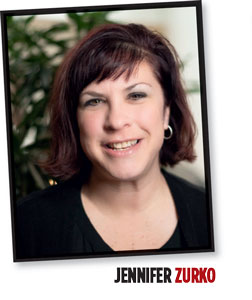5/30/2025
Investing in Change
Jennifer Zurko

I like hearing other people’s experiences and perceptions about change and how they handle it. Last year, author Miranda July wrote “All Fours,” which is about a woman in her 40s who sets off on a cross-country road trip to California, but a few miles from home, she checks into a motel and doesn’t leave for three weeks. She spends the time on some self reflection, about her life, her career and her relationships, what changed and what needed to change. Apparently, it was the talk of many a women’s book club and online chat rooms.
Ms. July started a Substack, which is quirky and insightful, that continues the conversation about life and change and constantly feeling in a state of flux. She was just on The New York Times’ Modern Love podcast discussing how the book was no accident and that it was inspired by her weekly get-togethers with a friend where they would “eat and talk about the idea that we were always changing.”
Using her friend as a sounding board was the tool she needed to look at how change affects women of a certain age and that they should embrace it, which inspired her to write a book. That’s just one way to look at something that you know needs changing, but you’re not sure how to go about it. You need the tools or inspiration to make that investment for change.
On the professional front, we use different methods to help us decide whether something is worth investing in or changing. Hopefully, it’s not forcefully thrust upon us as an emergency—like, if nothing changes, we’re in big trouble kind of situation. I’m talking more about the improvements, updates and implementations—both big and small—that you can do to help change your business for the better.
Expenditures on things like automation can be quite hefty and a big change to implement with your staff. It takes a cool head to step back and ask the right questions to really be sure it’s the right decision. Bossman Beytes looks at the different ways some of your grower peers calculate the return on investment on new equipment and systems.
You can learn how to change the way you propagate young plants by using LEDs to improve growth and uniformity.
Has it been a while since you’ve looked at the way you measure the light in your greenhouse? Maybe that needs to change. Researchers are studying how we should change our perception of growing substrates—not focusing on what’s in it, but the spaces in between. Read the first in a series of articles on pore science.
You may need to change the way you apply your biologicals. Luckily, Koppert has a tool for that. Also, columnist and grower Albert Grimm looks at ways we can check our egos at the door, admit our mistakes and change our mindsets so that it allows us to accept humility.
And I couldn’t end without mentioning the essays from this year’s finalists for our GrowerTalks/Ball Horticultural Company Young Grower Award. See what they said about the ways greenhouse businesses can make positive impacts for the future.
Change has been perpetually in my orbit lately. At work, at home and in my mind. I feel like I’m playing dodgeball, but I’m the only one on the other team and the barrage of balls that are hurled at me represent all of the changes I’ve been dealing with at once. You could say I’m truly invested in change lately.
But it’s not all bad. Actually, most of it is good. It’s just all at once, which can be hard to manage. Good thing I’m one of those people who doesn’t mind change, otherwise I’d be writing this from a fetal position in the corner underneath a pile of dodgeballs. GT